Wujin, Changzhou, Jiangsu, China – Monday, June 6th, 2011
Why was I more excited to visit World Joyland than I had been to visit most of the other Chinese amusement and theme parks? I told myself it was because it was “new;” the only park on my Asia 2011 tour that had actually opened for the first time in 2011, barely more than a month prior to my visit. But why should that fact have any bearing on my own subjective experience of the park? After all, subjectively-speaking, every single park I visited in Asia was new… to me. I’m not particularly an enthusiast of fresh paint that that quality alone should make the difference. It’s worth investigating the question of what qualities are bound up in the idea of “newness” that make it uniquely appealing?
 Part of it could be socially learned. It’s a claim to fame, of getting to be one of the first western visitors to ever visit a place, and being part of the very first conversation about the thing. Yet, as evidenced by when I actually got around to writing about this park, that really didn’t seem to be much of a factor after my visit. Maybe there’s a sense that going to visit something new is somehow “rarer” or a “bonus” experience? I wouldn’t have gotten to do the thing if I had planned my visit any earlier in time, so that makes it special. Plus, going any later would have been “wasted” time waiting, so visiting a new attraction is the most efficient way to visit things, and there’s happiness in efficiency. But this reasoning doesn’t hold up to much logical scrutiny, and either way it doesn’t feel emotionally important enough to be cause of the extra excitement. Maybe it’s just the aesthetic experience, and the excitement comes from being at the vanguard to witness the newest trends in coaster and themed design? World Joyland certainly promised to be uniquely different from the older, more generic competitors I had encountered so far, but that’s more of an intellectual stimulation, not quite the lizard-brained joy I felt that told me: “I get to go to the NEW theme park!” Or maybe it’s more existential. We’re finite
Part of it could be socially learned. It’s a claim to fame, of getting to be one of the first western visitors to ever visit a place, and being part of the very first conversation about the thing. Yet, as evidenced by when I actually got around to writing about this park, that really didn’t seem to be much of a factor after my visit. Maybe there’s a sense that going to visit something new is somehow “rarer” or a “bonus” experience? I wouldn’t have gotten to do the thing if I had planned my visit any earlier in time, so that makes it special. Plus, going any later would have been “wasted” time waiting, so visiting a new attraction is the most efficient way to visit things, and there’s happiness in efficiency. But this reasoning doesn’t hold up to much logical scrutiny, and either way it doesn’t feel emotionally important enough to be cause of the extra excitement. Maybe it’s just the aesthetic experience, and the excitement comes from being at the vanguard to witness the newest trends in coaster and themed design? World Joyland certainly promised to be uniquely different from the older, more generic competitors I had encountered so far, but that’s more of an intellectual stimulation, not quite the lizard-brained joy I felt that told me: “I get to go to the NEW theme park!” Or maybe it’s more existential. We’re finite bodies existing at a point in time, always forced to confront the fixed histories that define our identities and the future inevitability of our own ends. Is being in the fleeting temporal presence of the “new” a way to remind ourselves of the vivid urgency and ephemeral “nowness” of all lived experiences, and thus the ecstatic truth of our radical freedom?
bodies existing at a point in time, always forced to confront the fixed histories that define our identities and the future inevitability of our own ends. Is being in the fleeting temporal presence of the “new” a way to remind ourselves of the vivid urgency and ephemeral “nowness” of all lived experiences, and thus the ecstatic truth of our radical freedom?
If I had to guess, it’s probably a small combination of all of these reasons bundled together. (Yes, even getting to appreciate the fresh paint adds just a little bit more to the experience.) The excitement of experiencing “newness,” whether when we get a new car, see a movie or show on opening night, or visit an unusual theme park in its opening month, is inherently irrational and socially-learned… but it doesn’t mean the feeling isn’t authentic.
Either way, that additional excitement had transformed into additional anxiety as I was close to arriving. For one thing, I was late yet again. For another, there was steady rain on my way in, suggesting limited coaster operations.

 I’d most like have a bit of time to wander and explore in the rain before getting to ride anything major outdoors.
I’d most like have a bit of time to wander and explore in the rain before getting to ride anything major outdoors.
If you didn’t already know the story behind World Joyland, it’s pretty wild. The park is largely themed after Blizzard Entertainment properties like World of Warcraft and Starcraft. Activision Blizzard was not involved with licensing their IP to this park, much less were they part of the design process. Of course, seeing unlicensed IP in a Chinese amusement park is nothing new. Even seeing entire attraction designs duplicated from foreign parks (sponsorship and everything) is incredibly common.
But this was a whole new level of infringement. It wasn’t simply copied from something that already exists. This was an entire theme park based on original designs using a cohesive family of IP that had never been done as themed entertainment before. It wasn’t the usual shortcuts taken out of laziness or inexperience. This park was made using plenty of hard work and expertise, meticulously planned and built in the most earnest attempt I had encountered as of 2011 to meet international theme park standards. I suppose it’s easier to meet those standards if you don’t have to worry about a budget line item that requires paying fees to a license holder (who can often slow down the design and approvals process). Many would see World Joyland as the more efficient way of designing an IP-based theme park and… they’re not entirely wrong. But, even as critical as I am over copyright law and restrictions on Fair Use, and as ambivalent as I am towards mega-corps that practice exploitative game design and employment practices… it’s also not right.
item that requires paying fees to a license holder (who can often slow down the design and approvals process). Many would see World Joyland as the more efficient way of designing an IP-based theme park and… they’re not entirely wrong. But, even as critical as I am over copyright law and restrictions on Fair Use, and as ambivalent as I am towards mega-corps that practice exploitative game design and employment practices… it’s also not right.
Also on the subject of the joyful ridiculousness of World Joyland, the park reports that it cost $48 million dollars to build, which is total bullshit. A park like this is going to cost at least an order of magnitude more to build, realistically around a quarter to a half-billion, even if you control for excuses like “labor and materials are much cheaper because it’s China.” Price differentials for building theme parks in different parts of the world are pretty marginal. Most heavy construction materials like steel are still priced subject to international supply and demand, and cheaper local labor and supplies are usually balanced out by the extra cost to import specialized equipment and talent that doesn’t exist locally. (There’s all sorts of market economic forces at play to make sure these things equalize over time.) That B&M alone is guaranteed to cost at least half the proclaimed budget, and they probably paid a premium due to import fees and taxes. Whenever a theme park exaggerates its price tag, either highball or lowball, there’s usually a political or legal reason for it.
A park like this is going to cost at least an order of magnitude more to build, realistically around a quarter to a half-billion, even if you control for excuses like “labor and materials are much cheaper because it’s China.” Price differentials for building theme parks in different parts of the world are pretty marginal. Most heavy construction materials like steel are still priced subject to international supply and demand, and cheaper local labor and supplies are usually balanced out by the extra cost to import specialized equipment and talent that doesn’t exist locally. (There’s all sorts of market economic forces at play to make sure these things equalize over time.) That B&M alone is guaranteed to cost at least half the proclaimed budget, and they probably paid a premium due to import fees and taxes. Whenever a theme park exaggerates its price tag, either highball or lowball, there’s usually a political or legal reason for it.
Most of the sources I’ve read claims the park was divided into two sections based on the high-fantasy Warcraft and the sci-fi Starcraft, but from what I recall there seemed to be at least four or five separate theme zones, not including the entrance area.
The park is laid out a bit like Islands of Adventure; it even copies elements of Seuss Landing for its colorful Mole’s World family section located at the right side of the lagoon.
 Opposite the arrival plaza on the front left is Terrain of Magic, the main World of Warcraft inspired zone.
Opposite the arrival plaza on the front left is Terrain of Magic, the main World of Warcraft inspired zone.
At the back right is World Legend, another myth and fantasy styled zone that apparently also lifts aspects of World of Warcraft, despite being separated by a few zones from Terrain of Magic. Two of the park’s smaller roller coasters are located in this area.
 Behind World Legend is Holy Mountain, essentially just a big weenie structure on a hill, still under construction at the time.
Behind World Legend is Holy Mountain, essentially just a big weenie structure on a hill, still under construction at the time.
At the back left is the Starcraft themed area, Universe of Starship, including the signature B&M flying coaster that was my top priority even though it was still closed for rain.
And towards the middle is a fanciful multi-colored castle centerpiece overlooking the lake, appropriately known as Fairy Lake.
 I started with Terrain of Magic, where the largest and most obvious Warcraft characters could be found.
I started with Terrain of Magic, where the largest and most obvious Warcraft characters could be found.
Splash of Monster Blood is a shoot-the-chutes in the large mountain. I might have been tempted to see if anything was inside the indoor portion, but didn’t feel like getting drenched on an already wet day.
“If you would like to experience the primitive life as orcs, live in rock mountains glowing red flames, and stay with barbaric beasts, don’t miss this beast-bloody journey!” Uhh… no thanks?
The subtly misspelled Jouney of Dangers is the park’s signature World of Warcraft dark ride.


 The ride uses the Spider-Man style multi-motion vehicles with 3D media combined with practical sets. I recall the experience was delightfully over-the-top, with nonsensical action happening in all directions at all times, and characters freely leaping and bouncing across the screens with nary a regard for gravity.
The ride uses the Spider-Man style multi-motion vehicles with 3D media combined with practical sets. I recall the experience was delightfully over-the-top, with nonsensical action happening in all directions at all times, and characters freely leaping and bouncing across the screens with nary a regard for gravity.
If you forgot to bring a weapon to the park, you can buy a real sword on unrestricted display in the gift shop!
Speaking of swords, Ice Sword Kingdom seemed a mysterious show-based attraction that only promised to be “Actor Specific.”
This turned out to mean it was a Pepper’s ghost style stage show, somewhat similar to Mystery Lodge at Knott’s, featuring at least two actors. The story was all in Chinese, but seemed to revolve around a story of forbidden and/or unrequited elf love. Whatever gets folks off, I suppose.
I’ll skip Universe of Starship for now and move on to the next themed section, World Legend, which continues the high-fantasy theme.
The top attraction here was Dragon Roaring Heaven, the park’s Golden Horse mine train that, for all intents and purposes, was an exact clone of the Vekoma version I found at a couple of the Happy Valley parks.
As I was waiting in the queue, I heard a sound I couldn’t believe. There was already a train loading in the station, but at the same time, I could hear the clacking of one of the dual lift hills. Was it real? Yes, this coaster had TWO TRAIN OPERATION! Literally the first time I saw that on any multi-car train coaster at any locally-built and operated Asian park.
As a result, the queue went pretty quick and I was able to ride it a couple of times. The unique feature is a large dragon mouth tunnel that encloses both of the lift hills. However, like many of this style of mine train, the theme design is pretty basic after that point, with just a few generic rock elements sprouting out of an empty grass field with the coaster laid on top.
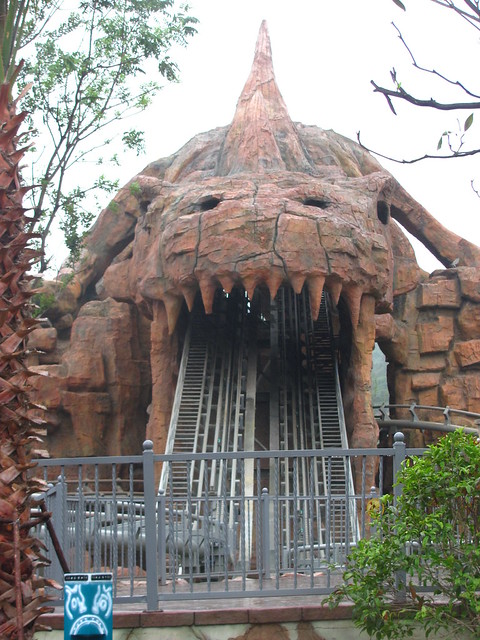




 I even managed to grab a POV video in the rain.
I even managed to grab a POV video in the rain.
Clouds of Fairyland sounds like the name for a kid’s coaster, but in fact it’s the park’s Maurer Rides SkyLoop coaster, making it the tallest and fastest coaster in the park.
The coaster is housed in an Arabian style castle, seemingly disconnected from the rest of the theme. I wouldn’t get to go inside, however, as the coaster wouldn’t open to the public until August.
Lastly, I tried an experience called Soul Hunter. This turned out to be an early augmented reality interactive walk-through.
A preshow featured this CG bespectacled fellow, who apparently needed help hunting down a bunch of invisible ghosts or spirits in his lab.
You’re given a backpack computer tethering a set of headphones and a gun with an augmented reality screen. Watch the screen to see “spirits” floating around each scene, then shoot them. There’s not much effort made to hide the tech or make it part of the story.
It was novel. I hadn’t tried anything like this in a theme park before, and despite the advances in technology it never really caught on in the following years, with VR becoming the next big thing. In 2011, it was frankly quite clunky, glitchy, and frustrating to use, although the gamers I went through with seemed to be into it.
At the back of World Legend is Holy Mountain, a hill with a large staircase leading to an iconic folly at the top. Again, it was still under construction so I couldn’t go up to see the park from above.
 Watch out. At World Joyland you can rent your own mini golf cart to drive around the paths and force bystanders to jump out of your way.
Watch out. At World Joyland you can rent your own mini golf cart to drive around the paths and force bystanders to jump out of your way.
The kid’s area is based on the Mole’s World video game. The game is developed in China and the park uses the name directly, so perhaps this one obtained formal permission?
In some ways, the infringement was the worst and most senseless in this zone, with the most direct copying of elements from Seuss Landing at Islands of Adventure, among others.
“That’s a penis.”
Fairy Lake had this elaborately designed castle that you could climb up for a view overlooking the central lagoon. It looks like a concept designer got to go pretty wild with this, although closer inspection show that not all the details hang together.
Fairy Lake was otherwise devoid of attractions. The only other offering I could find was this somewhat peculiar Art Nouveau building called Game Fort.
Inside was a totally mismatched and rather yawn-inducing video game demo room sponsored by Nvidia. (Despite their name and logo plastered everywhere, I’d still rate the chance that Nvidia actually had nothing to do with this around 50%.)



 Okay… there’s a lot to unpack from this image of a toy shop. I won’t try, but take your time with it.
Okay… there’s a lot to unpack from this image of a toy shop. I won’t try, but take your time with it.
Last zone: Universe of Starship. A gigantic sci-fi building looking like a giant golden tick sits in the middle of this zone. However, the scaffolding suggested that it wasn’t finished, whatever it was.
Rain was sporadic so I took refuge in the indoor queue of a 3D motion theater attraction called Cosmo Hacker.
The inside was notable only for its overwhelmingly grey drabness. At least it was dry.
Riders are seated in the most awkward plastic reclined chairs imaginable. As I recall, they offered little grip or back support, and when they started shaking randomly (no attempt to match the motion on the screen), I was at danger of slipping out from the ill-fitted seatbelt. Motion simulators are generally my least favorite style of attraction, and this was the worst version belonging to the genre I’ve ever done, so by default it ranks highly (lowly?) on my list of worst theme park attractions ever. The fact that the film itself was completely forgettable only bolsters the case.
Anger of Raytheon is a set of S&S shot towers named after a pissed-off battery. I thought maybe the name “Raytheon” was an older reference to an ancient god or a chemical compound or something, but apparently, no, the battery company made its name up because the word sounded cool and it refers to nothing else.


 CC Talk Show: I didn’t try this, but I assume it’s some sort of digital puppet show?
CC Talk Show: I didn’t try this, but I assume it’s some sort of digital puppet show?
“Is running into Jiongjiong a miracle or tragedy? Come and enjoy the fun of bickerring with him!”
Rated 3/5 for Splendor.
 The real suspense throughout the entire day was whether or not the star attraction, B&M’s Starry Sky Ripper flying coaster, would ever open in between bouts of rainfall.
The real suspense throughout the entire day was whether or not the star attraction, B&M’s Starry Sky Ripper flying coaster, would ever open in between bouts of rainfall.
The ride has a bit of an identity crisis. The main marquee says Sky Scrapper, although other signs suggest Starry Sky Ripper as the name. I first heard it by the Ripper name, and honestly Starry Sky Ripper sounds a lot cooler, even if it’s likely the result of a poor translation of the original intent.
Finally, the afternoon had a long enough dry period that the coaster came to life. I hurried into the queue to be among the first to ride.

 (Reference video from MiyaPA Masane.)
(Reference video from MiyaPA Masane.)
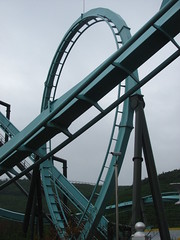 Starry Sky Ripper is unusual for a B&M flying coaster. In terms of element selection and sequence, this layout is by some measure the furthest from their median design. It boasts several unique elements while containing almost none of the usual maneuvers. The overall flow is quite different too, being less focused on a swooping, meandering free-flight sensation, and more focused on a progression of unique inversions and elements. I have a theory about the Starry Sky Ripper and how its unique layout came to be.
Starry Sky Ripper is unusual for a B&M flying coaster. In terms of element selection and sequence, this layout is by some measure the furthest from their median design. It boasts several unique elements while containing almost none of the usual maneuvers. The overall flow is quite different too, being less focused on a swooping, meandering free-flight sensation, and more focused on a progression of unique inversions and elements. I have a theory about the Starry Sky Ripper and how its unique layout came to be.
 I suspect that an early masterplan for the park used a layout of a Vekoma Flying Dutchman coaster as the placeholder for the park’s designated “flying coaster.” It’s fairly standard for park planners to use a common stock layout long before any manufacturer has been selected. The older and more common the design, the more likely it is that that will be the sample layout on file. When it became time to contract a manufacturer, Vekoma was pretty well out of the large scale Flying Dutchman game, but B&M had an obvious replacement product for sale. But I suppose the developers had come to like the look and layout of the Flying Dutchman, and asked B&M if they could do their own version of the layout. Because B&M’s flying coasters load from the flying position instead of the lay-down position, they had to make some pretty radical adjustments to the layout, especially to eliminate the first lie-to-fly and final fly-to-lie, but they kept the overall sequence of elements much the same.
I suspect that an early masterplan for the park used a layout of a Vekoma Flying Dutchman coaster as the placeholder for the park’s designated “flying coaster.” It’s fairly standard for park planners to use a common stock layout long before any manufacturer has been selected. The older and more common the design, the more likely it is that that will be the sample layout on file. When it became time to contract a manufacturer, Vekoma was pretty well out of the large scale Flying Dutchman game, but B&M had an obvious replacement product for sale. But I suppose the developers had come to like the look and layout of the Flying Dutchman, and asked B&M if they could do their own version of the layout. Because B&M’s flying coasters load from the flying position instead of the lay-down position, they had to make some pretty radical adjustments to the layout, especially to eliminate the first lie-to-fly and final fly-to-lie, but they kept the overall sequence of elements much the same.
Lift.
Drop.
Fly-to-lie. (With an extra full rollover.)
Vertical loop.
Lie-to-fly.
Double inverted corkscrew.
Helix & brakes. The same element sequence for both Flying Dutchmen and Starry Sky Ripper.
This theory is pure conjecture, and I have absolutely no special insider knowledge about how the design process actually played out. One obvious monkey wrench in the theory is that Starry Sky Ripper, with its elongated, almost out-and-back style layout, occupies a very different custom footprint than the more square plan of a Flying Dutchman, so it wouldn’t have been a simple “fill to specifications” situation, like the way B&M would later copy Vekoma’s family inverted coaster layout at Happy Valley Shanghai. Still, I suspect there was at least some degree of inspiration from the Vekoma version during the development, as it seems more than a coincidence why Starry Sky Ripper is so different from other flying coasters by the same Swiss designers, yet so similar to the flying coasters from their Dutch competitors.
Given that I generally like the Flying Dutchman design when it’s running smoothly, that’s a very positive development for the quality of Starry Sky Ripper. Most B&M flying coasters I tend to rate towards the bottom of their portfolio. As a general rule, their attempts to simulate flight feel awkward and forced, and the layouts too often put the big intense showstopper element at the beginning, then spend the rest of the layout riffing on a relatively sleepy motif of curves and rolls. The one other exception to that rule was a big one: Tatsu. By using the terrain to its advantage and turning the sequence inside out, that ride is an ecstatic reverie of flight that I would frankly rate as the best coaster in its home park, and I’d still rank as one of the top five B&M coasters I’ve been.
Starry Sky Ripper doesn’t quite live up to those heights, but it does about as well as could be expected as a moderate sized coaster on a flat plot of land. Probably in the top quartile of B&M coasters if I were to try to rank them. The coaster has a well-balanced sequence of elements yet never settles into a routine. Most of all, it’s consistently interesting, with at least three elements that rank among the most fun I’ve tried on a flying coaster. And it does it all without a single pretzel loop!
The steep, straight first drop feels almost like an inversion due to the flying orientation. The first large overbanked curve is thoroughly enjoyable as an introduction to the flying concept. The ride peaks with the 1½ zero-G roll, using the quick inline rotation to mix dizzying visuals with a wacky gravity-bending sensation. Dipping through a small tunnel, the vertical loop has a very different dynamic from the previous element, yet is no less of a unique heels-over-head sensation. The curving lie-to-fly is the third element in a row that messes with your sense of orientation while proving surprisingly graceful. (B&M understood how to work with the dynamics of this element in a way that Vekoma never did; they simply flipped the track on a flat banked curve, thus producing some awkward lateral forces at the mid-point.) The final curves and double-corkscrews are all somewhat prosaic in comparison to what came before, but they still have a place for making the layout feel complete and well-rounded, by highlighting the motion
The ride peaks with the 1½ zero-G roll, using the quick inline rotation to mix dizzying visuals with a wacky gravity-bending sensation. Dipping through a small tunnel, the vertical loop has a very different dynamic from the previous element, yet is no less of a unique heels-over-head sensation. The curving lie-to-fly is the third element in a row that messes with your sense of orientation while proving surprisingly graceful. (B&M understood how to work with the dynamics of this element in a way that Vekoma never did; they simply flipped the track on a flat banked curve, thus producing some awkward lateral forces at the mid-point.) The final curves and double-corkscrews are all somewhat prosaic in comparison to what came before, but they still have a place for making the layout feel complete and well-rounded, by highlighting the motion of gentle, continuous rotation that signifies closure and denouement.
of gentle, continuous rotation that signifies closure and denouement.
If everything else at World Joyland existed on a spectrum between delightfully bizarre and oddly awful, Starry Sky Ripper was the one attraction that was unambiguously good. That’s a quality that’s been in somewhat short supply so far on my Asian theme park tour. I’d have been gutted if I had missed it due to rain (especially after missing so many other new attractions across China due to slow construction or other reasons), and while the 45 minutes that the ride was open before it closed once again for weather wasn’t part of my ideal plan, it was still enough to get a satisfying three laps in before I’d be forced to move on.
My strange day at World Joyland would also be my last full day in mainland China for several years. I’d return to Shanghai that evening, get up early the next morning to take the Maglev Train to Shanghai Pudong International Airport, and would soon arrive at my next destination: Seoul, South Korea.





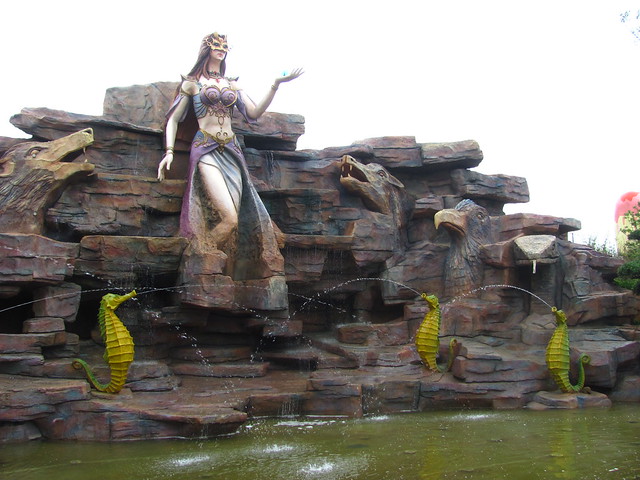



















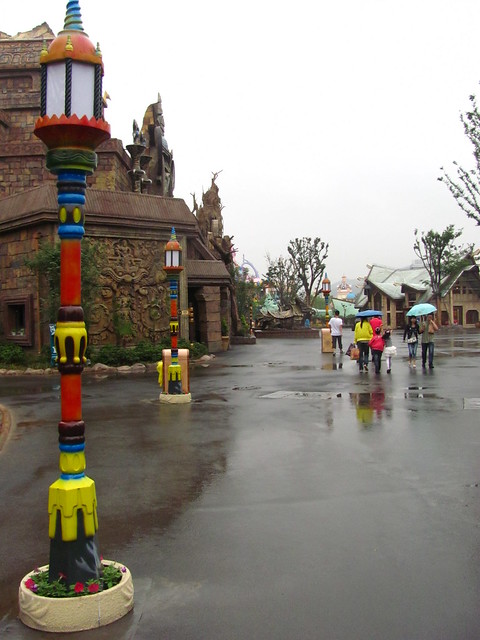








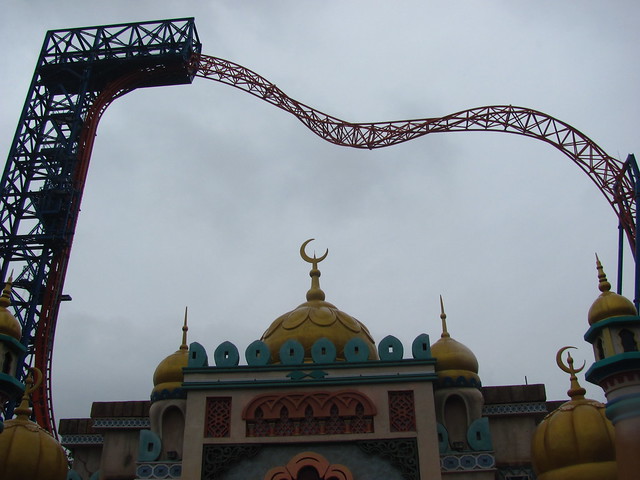






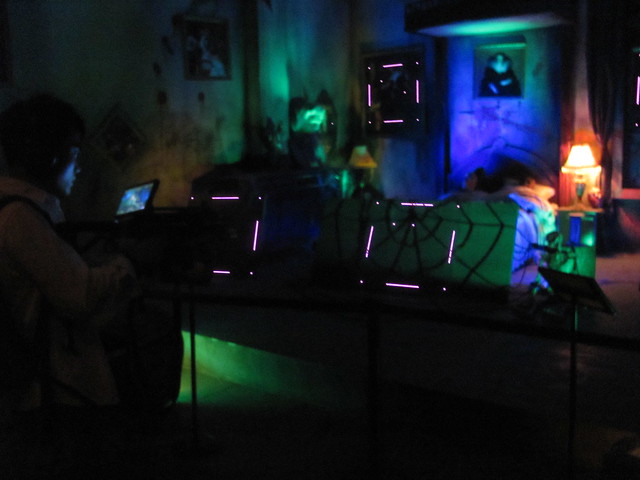









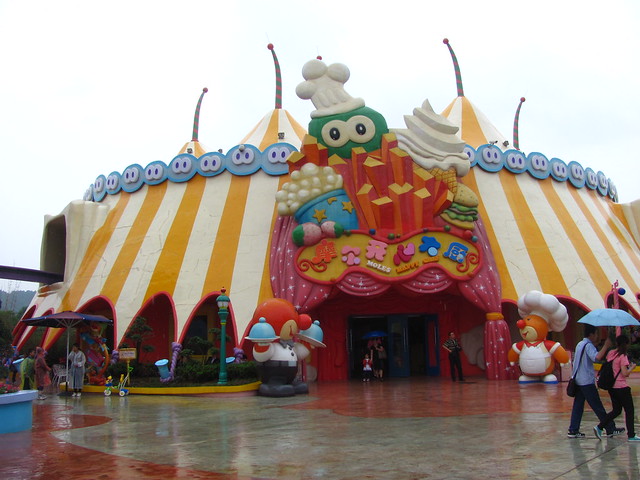



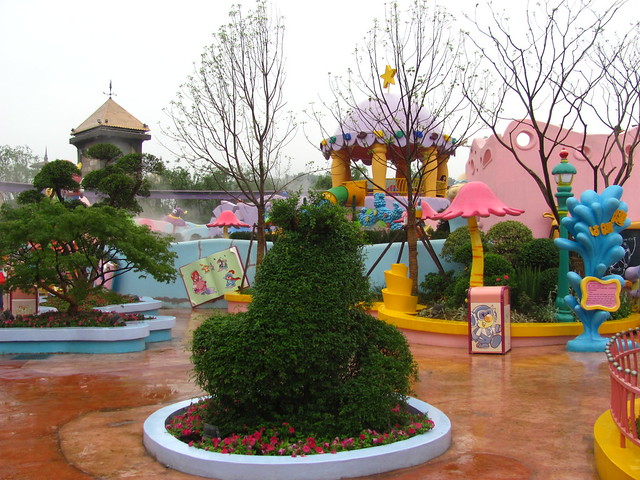








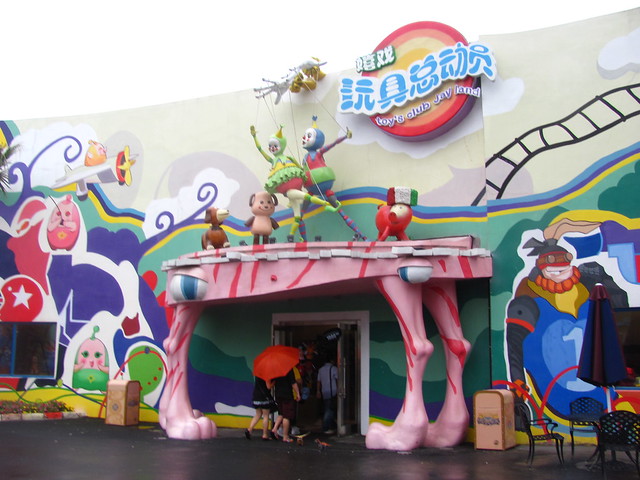

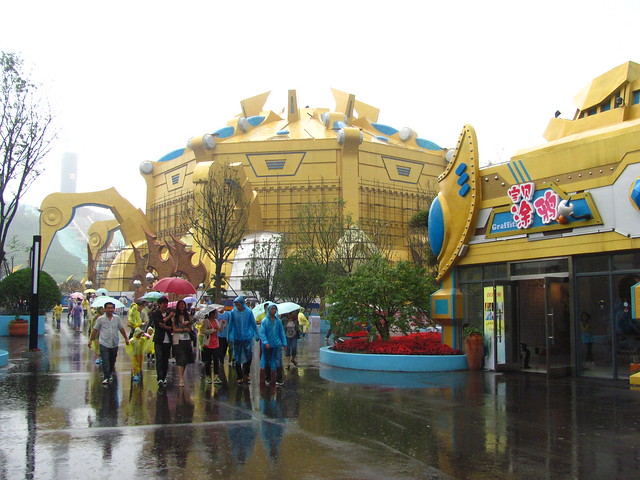


























I’ve been reading your blog for years now and it is such a delight to see your take on the wonderful weirdness of World Joyland; your insiders’ speculation on the origins for the layout of Starry Sky Shredder, or whatever that coaster is supposed to be called, is fascinating. I lived the expat life in Changzhou for three years, but have tragically only visited World Joyland once (it’s an long/expensive cab ride from the city), but can report that the second phase expansion that they added to the park sometime in the intervening years makes for an even more delightfully strange experience (I got very lost trying to find my way into the phase two expansion since the footpaths are astoundingly poorly-marked, and there’s a wonderfully nonsensical Journey to the West-themed dark ride using Forbidden Journey-style robotic arm vehicles with props in very easy grabbing distance of riders).
Thinking back on Changzhou’s two theme parks, I’m honestly struggling to decide whether World Joyland or China Dinosaurs Park should count as the more bizarrely/emblematically modern China of the two (taking the surrounding resort area into full account, China Dinosaurs Park might just win that one; would be very curious to read your thoughts on that park if you’ve visited it/if you will visit it in a post-pandemic Chinese itinerary).
Thank you, I’m glad you’ve enjoyed these new ramblings on old material!
I saw the updated map of the World Joyland expansion while doing research for this post and agree that it looks even wackier now than it did when it opened.
China Dinosaurs Park was another one that was on my radar, but it was pretty clear Dinoconda wasn’t coming soon enough for my trip so I skipped it. Not sure if I’ll get a chance to go back. Any future Chinese trips for me will probably be more focused on one or two specific theme parks and the rest on food and culture with my wife, so I’m glad I experienced as much as I did back in 2011.